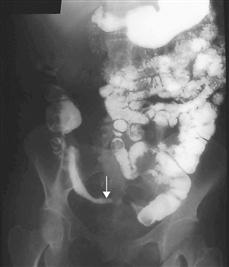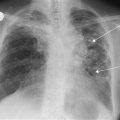Diarrhoea
Diarrhoea is an increased frequency of abnormally loose motions. The diagnosis of diarrhoea must be related to the patient’s normal bowel habit.
History
Infective enteritis
There is usually colicky abdominal pain and diarrhoea. The diarrhoea may be bloody. Cholera presents with cramping abdominal pain, vomiting and severe diarrhoea, described as ‘rice water’ stools. There may be fever, rapid dehydration, collapse and death. In infective enteritis, check for ingestion of any unusual food or whether anyone else has been affected in the family. Check for a history of foreign travel (traveller’s diarrhoea). C. difficile is the most important cause of hospital-acquired diarrhoea. Over 80% of infection occurs in those over 65 years of age, affecting particularly those who have been treated with broad spectrum antibiotics. Infection ranges from mild to severe diarrhoea to more, unusually, pseudomembranous colitis.
Inflammatory bowel disease
Both Crohn’s disease and ulcerative colitis present with frequent diarrhoea with blood, and occasionally mucus and pus, associated with colicky abdominal pain. The patient may be toxic and febrile, with abdominal pain and distension if toxic dilatation of the colon has occurred.
Malabsorption
In addition to diarrhoea, there may be offensive stools, which are fatty and float, i.e. steatorrhoea. Has the patient had any previous surgery for resection of the bowel to suggest short bowel syndrome, or any bypass surgery to suggest blind loop syndrome? Is there any history of abdominal radiotherapy?
Neoplastic
Carcinoma may cause diarrhoea associated with colicky abdominal pain and the passage of blood and mucus PR. The diarrhoea may be spurious, liquefied stools only passing through an area of obstruction, with faecal masses behind the obstruction. Loose watery mucus passed frequently may be associated with a villous adenoma, the patient complaining of weakness associated with hypokalaemia due to the passage of excessive mucus rich in potassium.
Other intestinal
Diverticular disease may cause diarrhoea. The condition usually occurs in the older patient. The patient will also complain of associated colicky abdominal pain and pain usually in the left iliac fossa. Irritable bowel syndrome may cause similar symptoms to diverticular disease but occurs in the younger patient. Faecal impaction may result in spurious diarrhoea, while an ileocolic fistula associated with diverticular disease or rectosigmoid carcinoma is also associated with diarrhoea. Ischaemic colitis usually presents in an elderly patient with colicky abdominal pain, diarrhoea and passage of dark-red blood PR.
Gastric
Check for a history of gastric surgery. Destruction of the pylorus or section of the vagus nerve may result in diarrhoea, often associated with dumping. Vagotomy is rarely, if ever, performed nowadays.
Pancreatic lesions
These may result in diarrhoea or steatorrhoea. Check for a history of cystic fibrosis. The patient may have chronic pancreatitis, in which case there may be chronic back pain associated with epigastric pain and weight loss. Check for a history of pancreatic surgery. Patients with carcinoma of the pancreas may also present with diarrhoea.
Endocrine disorders
Diabetes is associated with an increased incidence of diarrhoea. Check for a history of thyroid disease. The patient may prefer cold weather and complain of sweating, anxiety, tremor and have obvious eye signs. The patient may also have noticed a goitre. Carcinoid syndrome may present as flushing (especially after alcohol, coffee and certain foods), asthma and loud bowel sounds, i.e. borborygmi. Patients with Zollinger–Ellison syndrome may have a past history of recurrent peptic ulceration, with haematemesis or melaena, in addition to diarrhoea. VIPoma is rare but presents with severe watery diarrhoea associated with potassium loss, with weakness due to hypokalaemia. Check whether the patient has a goitre, as diarrhoea may be associated with medullary carcinoma of the thyroid. Symptoms and signs of hyperparathyroidism and phaeochromocytoma may also be present (MEN syndrome).
Drugs
Take a careful drug history, especially for recent antibiotics, laxative abuse, proton pump inhibitors, sorbitol (in sugar-free foods), the ingestion of magnesium-containing antacids or recent cytotoxic agents.
Examination
Infective enteritis
The patient may be dehydrated or collapsed. Check for tachycardia and hypotension. There may be abdominal tenderness and distension. Digital rectal examination may reveal blood and pus on the examining glove.
Inflammatory bowel disease
There may be little to find except for mild, localised tenderness. In toxic dilatation, there will be fever, malaise, abdominal distension, vomiting and localised tenderness. Perforation may occur with peritonitis. An abdominal mass may be palpable with Crohn’s disease.
Neoplastic
There may be abdominal distension if obstruction has occurred. There may be a palpable abdominal mass. Digital rectal examination may reveal a carcinoma or a villous adenoma.
Other intestinal
With diverticular disease, there may be little to find other than tenderness in the left iliac fossa. The findings are similar in irritable bowel syndrome. With faecal impaction, rock-hard faecal masses may be palpated in the abdomen and may be felt on digital rectal examination. There may be little to find with an ileocolic fistula. With ischaemic colitis, there will be tenderness and guarding in the left side of the abdomen. Rectal examination will reveal dark-red blood.
Gastric
Other than a scar and history of gastric surgery, there may be nothing else to find on examination.
Pancreatic
With pancreatic carcinoma, there may be epigastric tenderness or a palpable mass in the epigastrium.
Endocrine
With thyrotoxicosis, there will be tachycardia, sweating, brisk reflexes, eye signs and a goitre. With carcinoid syndrome, there may be hepatomegaly and signs of tricuspid incompetence and pulmonary stenosis. In Zollinger–Ellison syndrome, there may be little to find on examination. With VIPoma, other than weakness due to hypokalaemia, there may also be little to find on examination. With medullary carcinoma of the thyroid, there will be a palpable goitre.
General Investigations
■ FBC, ESR
Hb ↓ bleeding. PCV ↑ dehydration. WCC ↑ infection. ESR ↑ inflammation, tumour.
■ U&Es
Urea ↑ dehydration. Potassium ↓ severe diarrhoea, villous adenoma.
■ LFTs
Alkaline phosphatase ↑ with liver metastases.
■ Stool culture and microscopy
Infective causes. Microscopy for parasites.
■ Sigmoidoscopy
Carcinoma, inflammatory bowel disease, villous adenoma, pseudomembranous colitis.
■ Barium enema
Tumours, colitis, diverticular disease.
■ Colonoscopy
Tumours, colitis (extent and severity), diverticular disease.
Specific Investigations
■ TFTs
T4 ↑, TSH ↓ in thyrotoxicosis.
■ 24-hour urine
5HIAA↑in carcinoid.
■ US
Carcinoid. Liver metastases.
■ Serum gastrin
Zollinger–Ellison syndrome.
■ Serum calcitonin
Medullary carcinoma of the thyroid.
■ Serum vasoactive intestinal peptide
Raised in VIPoma.





